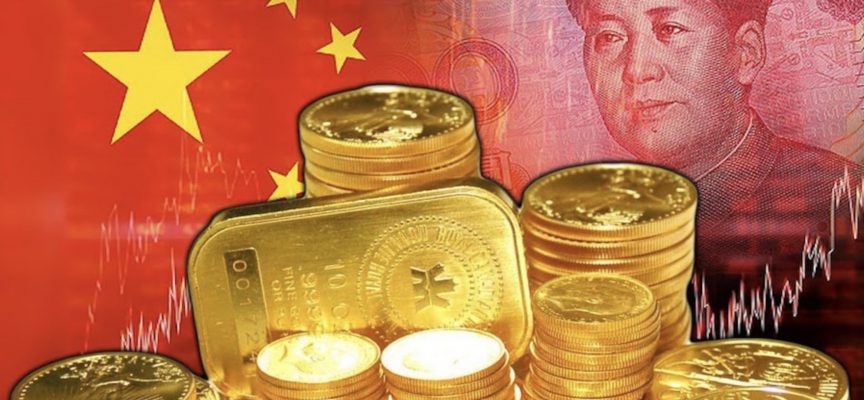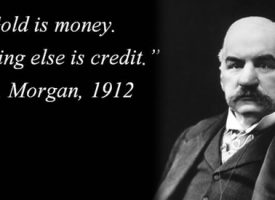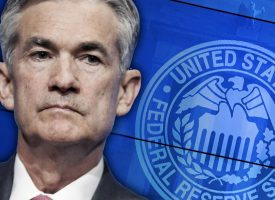As we move through trading in the back half of December, one of the greats in the business said the price of gold will surge well above $2,000 as the bull market in gold is only just beginning.
Since The Great Financial Crisis Started
December 16 (King World News) – John Ing: For much of the past half century, the dollar was as good as gold, but in 1971 the Fed abandoned the gold standard and unfettered by the gold backing, the Fed created so many dollars that much of the world’s commerce trades in greenbacks. America’s fiat financial hegemony also allowed the US government to print money to wage wars, pay its bills and consume more than it produces. The US as a result has been living beyond its means for over a half century. America was allowed to borrow from abroad forever, contributing to the Great Inflation of the 70s, the financial crisis of the 80s, and the dot-com bubble in the 90s. And, America racked up more debt to fight wars ($7 trillion for Iran and Afghanistan alone), exacerbated by the 2008 financial subprime crash which led to the need for Wall Street’s bailout that cost billions and now trillions of fiscal stimulus.
That easy money created by the rounds and rounds of quantitative easing was supposed to fund growth after the financial collapse in 2008, but instead caused the Fed’s balance sheet to explode from 6 percent GDP in 2008 to over 18 percent this year. Wall Street is less concerned about America’s troubled public finances and that government debt has spiraled out of control. Investors too seem unconcerned about whether they will be repaid. Yet the stock market posts new record highs, again and again.
In inflating asset bubbles, the Fed became a creator of money rather than a steward. The Fed’s experimental tools like quantitative easing, meant massive multi-trillion bond-buying programs to bring about near zero rates. Recent developments have laid bare the problems of this experimental program. Deficits don’t seem to matter, although as a percentage of GDP it is more than 4 percent now. However the present system is breaking down, while deficits keep rising.
There is a cost, a tipping point. The US has become the largest debtor in the world, jeopardizing the dollar’s status as the world’s reserve currency, particularly at a time when the US and China are going in different directions. China has become the world’s largest buyer of energy, most commodities and is doing more business in euros, rubles and yen, but not the dollar. China is setting prices and its dedollarisation has shifted to gold. Of note is that China is also the largest foreign holder of US debt. We believe the president’s spiraling trade and currency wars threaten to topple the dollar’s supremacy, which depends upon not just America’s economic or military prowess, but also the strength of its institutions. It is precisely these pillars that Mr. Trump is eroding.
US Repo Market Meltdown – Déjà vu
Negative interest rates began in Sweden in 2015 when the Riksbank lowered interest rates and the sugar rush of lower rates sparked a housing boom with prices climbing 15 percent. Inflation too picked up, but debt rose faster. Four years later, however it is a different story. Prices are off some 10 percent and inflation too has declined from two percent to 1.5 percent. The honeymoon is over and left is a bigger debt. The Swedish Central Bank has reversed course, ending the negative rate experiment. Negative interest rates, like cheap money was not the panacea. Yet negative rates have spread from Sweden to Europe to Japan as governments pressure their central banks to lower rates or intervene in currency markets to gain a competitive advantage. This time the next financial crisis, we believe will be triggered by the central banks…
ALERT:
Mining legend Ross Beaty (Chairman Pan American Silver) is investing in a company very few people know about. To find out which company CLICK HERE OR ON THE IMAGE BELOW.
 Sponsored
Sponsored
Particularly worrisome is a decade after the financial crash of 2008 when some ten million homeowners lost their homes, the $2.2 trillion US money market is again at the epicenter of a cash shortage. The system is breaking down. Markets were stunned in September when the cost of borrowing cash overnight spiked to nearly 10 percent form the usual level of 2 percent. The repo market is the keystone of a well functioning financial system and the canary in the coal mine. What was once thought to be a overnight intervention has now become monthly injections or a QE4 as the Fed in its lender of last resort role, pledged to purchase up to $60 billion of Treasuries each month to push liquidity into the cash short money market. Last month, the Treasury injected almost $100 billion and to date the Fed has pumped hundreds of billions to shore up a broken repo market.
Liquidity Crisis Exposes Vulnerabilities
We believe that the Fed was forced to step in because the money market players, Wall Street banks and hedge funds were reluctant to replace their short-term Treasuries because some held higher yielding paper, which resulted in a liquidity squeeze amid the repo market turmoil. In addition, with some 90 percent of the reserves held by the big five Wall Street banks, there may be a counterparty problem. Of note, at the current rate of injections, the Fed will soon own 12 percent of U.S. Treasury bills, monetizing America’s debt.
The Fed Will Soon Own 12% Of All U.S. Treasuries

All the same, negative rates are a financial stability risk and with some 25 percent of high-grade government bonds trading at negative yields, the years of cheap rates has put the portfolios of savers, life insurance, pension funds at risk. Savers are penalized and borrowers are rewarded. To no surprise total household debt has reached almost $4 trillion in the third quarter, surpassing the previous peak in 2008. Negative yields force holders to take a loss when held to maturity. Bond returns traditionally provided the offset for liabilities but today, savers face fading returns from mainstream bonds, forcing them to borrow or chase returns from riskier investments. This leaves the pension system the choice of paying more or cutting benefits. Corporate credit quality too has steadily deteriorated for decades. In the 1990s the debt ratings of median corporate debt was investment grade. Today they are a notch above junk, making it more difficult for large investors who can hold only investment grade paper. Despite the Fed\s efforts to calm the repo market, investors may find themselves in the eye of the storm again just as the swamp drains.
The Swamp is Draining
At the same time, we now see the ugly frogs. Years of cheap money and riskier markets have caused a growing number of businesses to borrow more, to levels not seen since the global financial crisis, creating bubbles of epic proportions. Gigantic unicorns WeWork and Uber have seen investors erase $100 billion of value this year. Woodford Investment Management in the UK, a huge hedge fund started in 2014 suddenly collapsed when Woodford’s misplaced bets caused investors to liquidate their holdings. SoftBank Group has poured billions into WeWork which was once valued at $47 billion and was forced to pour good money after bad, to rescue WeWork after abandoning its IPO. SoftBank put almost $10 billion into WeWork to keep it afloat but the rescue has brought SoftBank’s total commitment close to $20 billion, for a business currently valued at less than $8 billion…
IMPORTANT:
To learn which junior explorer is looking to drill multiple major tier one discoveries CLICK HERE OR ON THE IMAGE BELOW
 Sponsored
Sponsored
Both so-called investments were driven by the endless upward climb in stock prices as investors bought shares at higher prices in the belief that they would go higher. Amid the illusion of ever higher prices, no one thought of losses and like a game of musical chairs, the music continued. Until now.
Billionaire Bashing
Against this backdrop, billionaire bashing has become de rigeur in these populist times. In the United States, the vilification of billionaires and soaking the rich surfaces every four years as part of the election cycle. However, this time, Senator Elizabeth Warren has the super-rich fuming over her threat to impose a general wealth tax on the wealthiest Americans that has resonated globally. In fact, it is not that they are billionaires, but it is the 70,000 page tax code built up over the last half century that everybody should be attacking. Every few years, the system is stoked by politicians in a “them versus us” and with public trust in Washington at record lows, the rich make great scapegoats. Part of the reason for the unpopularity is not the rhetoric, but when these politicians become legislators, they create the very loopholes that everyone and billionaires included, take advantage of.
In other times, billionaires or even millionaires were put on pedestals as achievers, but today, Senator Warren and others believe that those who “have” should be taxed more than those who “have not”. The income disparity includes eliminating borrowings on investments which are tax deductible, including mortgages. In addition, tax brackets between states are disparate, such that billionaires often shift residences in order to shelter or lower their tax bite as the current president did, leaving New York for Florida. Québec and Canada once tried surtaxes as well as the federal government but proved to be ineffective and subsequently were scrapped. Wealth taxes were tried in Sweden and Germany, but they too were scrapped. The record is simply that wealth taxes do not work.
In fact, it is not only in the United States that billionaire bashing is a popular sport but in the UK, Labor leader Jeremy Corbyn started his campaign promising to make the 0.0001 percent pay. However, billionaires do not leave their cash in banks. Many countries tax income higher and of course there are just so many different type of taxes from capital gains to inheritance taxes. The point is that the tax code needs to be changed. For billionaires to pay more, legislators need to get together. And, many legislators cannot even agree to sit, let alone follow through on their promises. Taxes, it seems is largely for others to pay.
America’s Achilles’ Heel is Its Debt
Worrisome, is that with the swamp draining, the sky-high debt hangover remains. America’s Achilles’ heel is that almost one third of America’s debt is held by foreigners. The big concern are the credit markets. Far too many of us have too much debt. America’s “go it alone policy” leaves few friends and fewer reasons to hold America’s debt. The only thing that ever underpins a fiat currency is trust that governments are credible. That is being tested to the limits. In fact, foreigners possess huge economic leverage over the United States and already, some are losing confidence in the dollar or hedging their bets by buying gold. Others are balking at participating in the Treasury auctions because of lower returns and the repo market implosion is a warning.
During the past decade, easy money caused investors to chase alternative assets such as real estate, private equity and it is this boom that is vulnerable as the underpinnings of tariff wars and macro- geopolitical tensions erode confidence in the markets. We believe the economy is much more sensitive to a downdraft in valuations and the risk of contagion from the collapse of former unicorns like WeWork or the pot bubble in Canada or the repo debacle is a prelude to a return to earth…
BONUS INTERVIEW:
To listen to billionaire Eric Sprott discuss his prediction for skyrocketing silver
as well as his top silver pick CLICK HERE OR BELOW:
Another major headwind is the securitisation of markets where the derivatives market has grown larger than 2008, estimated today at 20 times the world economy. Of concern is that the world’s largest pension fund, Japan Government Pension Investment Fund (GPIF) will no longer allow its shares to be lent out from its portfolio sending shockwaves through the derivative world’s plumbing. Short sellers borrow and pay pension players a stipend to bet on a fall in prices, particularly index players. The potential damaging aspects is that without the shares, the markets could freeze or like a muscle, atrophy. Similarly there is the rush into index exchange traded funds (ETFs) where there are duplication in portfolios that could exacerbate any market exodus in an illiquidity crises as these funds dump holdings causing a cascading effect. The system is vulnerable to any downturn and the capital markets are riskier today. As the swamp drains, gold is a good thing to have.
All That Glisters is Gold
Gold climbed to 6-year highs, as a haven and barometer of financial uncertainties. Also there is a strong correlation with the amount of $12 trillion of negative yield sovereign debt or one third of the global bond markets and gold. Unlike these bonds, gold retains its value. Concerns of America’s deteriorating financial position, particularly with an election around the corner, has also spurred central bank purchases. We believe foreign investors are increasingly unwilling to fund out of control federal deficits. Without confidence in the dollar, the world has no reserve currency.
A deeper problem is that investors are increasingly concerned that the world will stumble again into a cycle of competitive devaluations and tariff morass. Just as America displaced Britain as the world’s pre-eminent economic power after World War II, so, too, do the large debt and fiscal pressures confronting the West, the rise of China and other economic entities, change the dynamics of the international monetary system. The problem is not a new one.
With half-century-old relationships severed, countries are retreating into regional economic blocs. As such, it is hard to believe that our leaders would repeat the economic disasters of the past, particularly when the world’s financial system is more leveraged, unstable and more dangerous than on the eve of the Lehman crisis. Quantitative easing, zero and negative interest rates have pushed investors to take on more risk as they seek better returns. Of concern is that the confluence of factors echoes the blunders of the 1930s. The longer the search for yield, the greater the probability of another financial crises. Gold is a good thing to have. Consequently we expect gold to record new highs, reaching $2,200 an ounce within 18 months.
As Good as Gold
For much of the past five years, gold was stuck in a 2 year trading range but traded up to $1,500 this year on concerns over the impact of the US-China trade war on global growth. Demand for gold remains strong particularly from central banks, while supplies remain uncertain. China remains the world’s largest consumer and producer of gold as gold moves from the West to the East. Both Russia and China have moved out of dollars for reasons both economic and political. They have bought gold every month this year becoming the fifth and sixth holder respectively.
Central banks have become net buyers for the second year in a row as many hedge their bets on American hegemony. Last year 22 central banks bought gold as a hedge against the dollar as well as to build up their respective reserves. Germany purchased gold for the first time in 21 years, joining Russia, China and 14 other central banks. Geopolitical forces will continue to support safehaven buying. After all, a year from now, the Americans will elect an inflationary president. Gold is a good thing to have.
This bull market is only beginning.
***To listen to Adrian Day’s powerful KWN audio interview discussing the gold and silver markets and much more CLICK HERE OR ON THE IMAGE BELOW.
Look At What Just Hit Highest Level Since 1999!
READ THIS NEXT! Look At What Is Soaring And What Just Hit The Highest Level Since 1999! CLICK HERE TO READ.
© 2019 by King World News®. All Rights Reserved. This material may not be published, broadcast, rewritten, or redistributed. However, linking directly to the articles is permitted and encouraged









